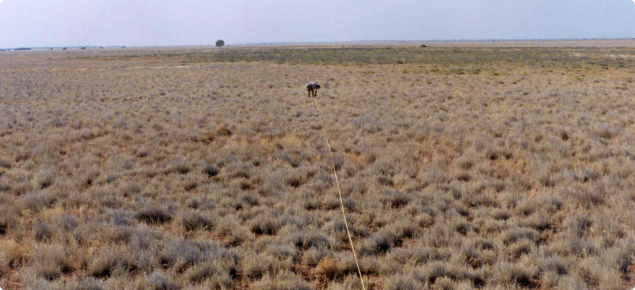Pasture potential
Pasture value is high, with numerous ephemerals and perennial grasses and herbs providing nutritious grazing after rain. Roebourne Plains grass is not particularly palatable to livestock, but is usually grazed after the short-lived perennial herbs and annuals have been consumed. It provides reasonable quality forage for several months into the dry season. When mature, its palatability and quality deteriorates considerably and in prolonged dry periods the pasture provides only a sub-maintenance ration for stock.
Suggested levels of use (per annum)
- Good condition: 20 hectares per cattle unit (ha/cu).
- Fair condition: 40 ha/cu.
- Poor condition: 50 ha/cu.
Managing Roebourne Plains grass pastures in the Pilbara
Roebourne Plains grass pastures can be used for year-long grazing, but palatability and feed quality are poor when dry and mature. For good productivity, the best use is to stock when the feed is green and actively growing (six to nine months of use).
Patch grazing and management
Repeated grazing of patches, while virtually ignoring other areas, is particularly noticeable on this pasture. Once a tussock has been grazed, it produces new leaves which are lower in fibre and higher in protein than the older material on ungrazed tussocks. The new growth is preferred by animals that return to the grazed tussocks again and again. Patch grazing over a number of years can result in the death of tussocks and the development of bare patches.
Burning grasslands to eliminate patch memory has been successful in the tropics, but has not been tested in the Pilbara. Likely problems are:
- burning may kill tussocks if the next season fails
- in most seasons, Roebourne Plains grass pastures do not generate sufficient fuel to carry a fire
- special measures may be required to keep kangaroos off the pasture after a burn to stop overgrazing and killing tussocks.
An alternative to burning may be to crash graze these pastures to eliminate patch memory. This would mean grazing with very large numbers of animals for short periods on some type of cell grazing system. This approach has not been tested in the Pilbara but is a possibility.
Spelling
Whatever grazing system is used it is desirable that these pastures are occasionally spelled for a few months after a good season to enable tussocks to recover and seedlings to establish. Roebourne Plains grass recruits very easily from seed in some years but it is unlikely that favourable conditions occur every year. Careful management involving deferred stocking is necessary to take advantage of recruitment events.
Roebourne Plains grass pastures in fair or poor condition will require spelling over a number of consecutive wet seasons and conservative grazing levels at other times in order to improve condition. Severely degraded and eroded (SDE) areas can be regenerated by protection from grazing, and mechanical works such as water ponding that will increase water infiltration and provide niches for grass to re-colonise. However, it is far more desirable to keep this pasture in good or fair condition by manipulating grazing pressure and season of use rather than going to the expense of mechanical regeneration.
Pasture condition
Assess the condition of this pasture type by the degree of ground cover (% basal area) afforded by grass tussocks, the vigour of the tussocks and the age structure of the stand and the presence or absence of soil erosion.
Traverse data (362 observations) during the Pilbara rangeland survey 1995-97 recorded:
Pasture condition: very good 8%, good 24%, fair 23%, poor 28%, very poor 17%
Soil erosion: nil 70%, slight 5%, minor 7%, moderate 8%, severe 5%, extreme 4%.
The condition of Roebourne Plains grass pastures varies considerably from very good to very poor and soil erosion is common.
Heavy grazing pressure on plains of the Cane, Horseflat, Onslow, Paradise, Pullgarah and Yamerina land systems has resulted in areas where Roebourne Plains grass has been lost and soil surfaces eroded. Water and wind erosion has resulted in sheeting, scouring, scalding and hummocking. Some areas, notably in the Cane, Horseflat, Paradise and Yamerina land systems, are severely degraded and eroded.
On the Horseflat and other land systems, the natural mosaic of dense Roebourne Plains grass (gilgaied areas) and less dense grass (non-gilgaied areas) can be exacerbated by over use. The less dense areas can become devoid of perennial grass resulting in patchy scalds that may be actively eroding or protected by dense stony mantles.
Very good–good condition
In good condition (Figure 1), there is a dense population of Roebourne Plains grass tussocks, with a basal cover of 3 to 5% or more of the soil surface and there is no soil erosion. Basal area of tussocks (rather than foliar cover % which varies with seasonal and grazing effects) is a consistent way of measuring the health of a tussock grassland from year to year. Tussock bases persist in both drought and good seasons and can be measured (basal cover %) despite being hidden by stems and leaves in good seasons.
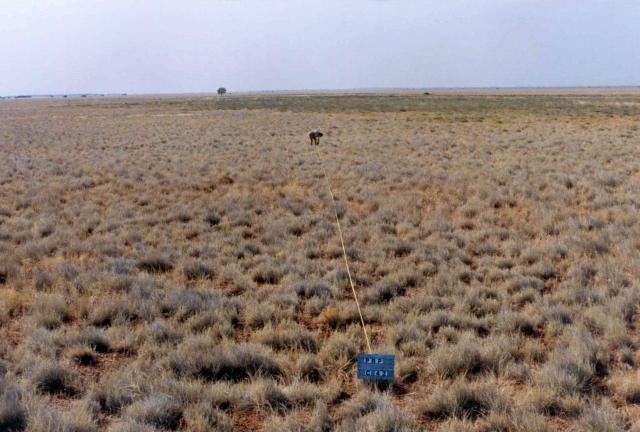
Fair condition
In fair condition (Figure 2), this pasture consists of common but scattered tussocks of Roebourne Plains grass that have a basal cover of between 1 and 3%. There is usually no soil erosion. Increasers such as feathertop three awn (Aristida latifolia) and black soil poison (Stemodia kingii) may be present but not in large numbers.
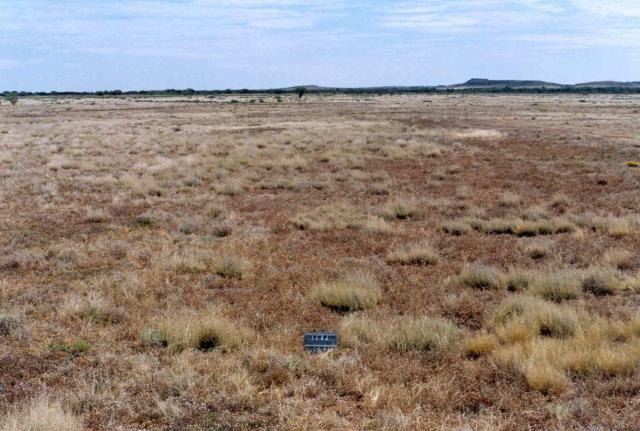
Poor–very poor condition
In poor condition (Figures 3, 4), this pasture type supports isolated or very patchy tussocks of Roebourne Plains grass with a basal cover of less than 0.5% and soil erosion is common. In extreme situations, tussocks are absent or occur only as rare dead butts. Occasionally there may be large numbers of undesirable increasers, such as cassias (Senna spp.) or black soil poison (Stemodia kingii), but more typically the stand of grass becomes much thinner and patchier and is not replaced by other perennial plants.
The soil surface commonly seals over and large scalded areas may develop, sometimes with wind piling and hummocking at the margins.
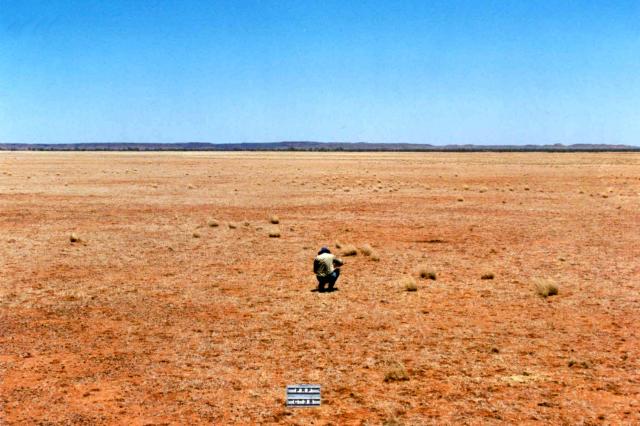
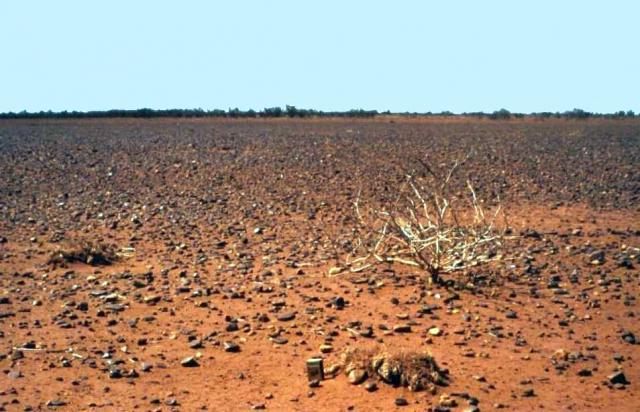
Vegetation structure and composition
The pasture type occurs as tussock grasslands on open, treeless plains that may extend for 5 or 6km or more. A feature of the pasture is its occurrence as a natural mosaic of dense and less dense patches of Roebourne Plains grass (Eragrostis xerophila) over the plains. Variations in micro-topography and soil properties are probably responsible for the patterning.
Roebourne Plains grass occurs with a basal cover of up to 10% (but most commonly 5% or less) and is often associated with patches of swamp grass (Eriachne benthamii) or neverfail (Eragrostis setifolia) on the larger gilgai depressions. Other perennial grasses which may occasionally occur as sparse patches or isolated tussocks within the stand are barley Mitchell grass (Astrebla pectinata), ribbon grass (Chrysopogon fallax) and native panic (Panicum decompositum).
Shrubs are generally absent or isolated although there are sometimes patches of snakewood (Acacia xiphophylla). Occasionally, on weakly gilgaied saline plains of the Horseflat and Cheerawarra systems, Roebourne Plains grass is associated with giant bindii shrubs (Sclerolaena hostilis) up to 1m tall with projected foliage cover (PFC) up to 15%.
Beard (1975) suggests that parts of the Roebourne Plains may originally have carried silver saltbush (Atriplex bunburyana) in addition to perennial grasses. Isolated plants of silver saltbush were seen on the Horseflat land system. Larger relic patches are present near the Roebourne airport. Here they take the form of low shrublands of saltbush and giant bindii (PFC 5–10%) with prominent patches of Roebourne Plains grass and scattered ribbon grass and buffel grass. Such areas are a saltbush pasture type rather than Roebourne Plains grass pastures. They are of very limited extent and are best described as bluebush–saltbush pastures.
Occurrence
Approximate area 5280 km2 (2.8% of total).
Extensive areas of this pasture type are found on the Roebourne Plains, as the name implies, and along the valleys of major rivers, such as the Fortescue, De Grey and Oakover. It is common on land systems such as Brockman, Horseflat, Pullgarah and Yamerina and is a minor component of many other systems.
It grows on old alluvial plains (and some plains developed in situ on basalt) with alkaline, cracking clay soils, often with weak crabhole (gilgai) microrelief, and which are generally saline at depth. Soil colour is red or reddish brown and greater than 1m deep. Surface mantles are absent or common to abundant as pebbles and cobbles of ironstone, basalt and other rocks. The plains are not generally subject to inundation.
Associated plants
Other resources
- Beard, JS 1975, Vegetation Survey of Western Australia. 1:1 000 000 Vegetation Series sheet 5 - Pilbara. Map and explanatory notes, University of Western Australia Press, Nedlands, Western Australia.
- van Vreeswyk, AM, Leighton, KA, Payne, AL, & Hennig, P 2004, An inventory and condition survey of the Pilbara region, Western Australia, Department of Agriculture and Food, Western Australia, Perth. Technical Bulletin 92.

